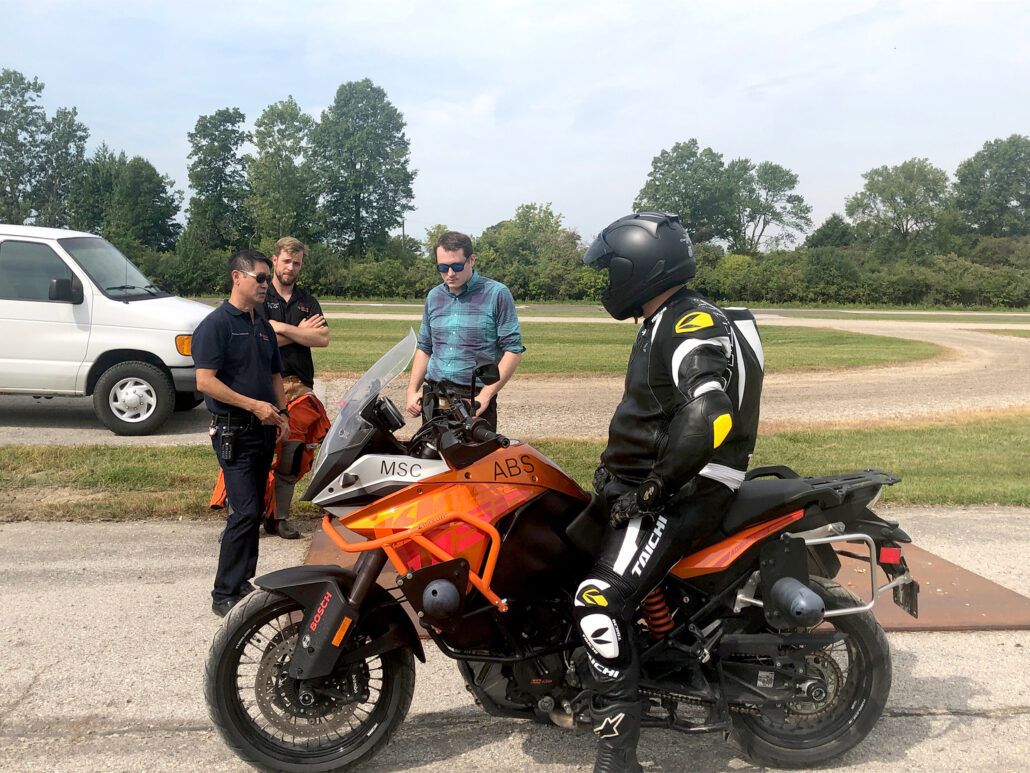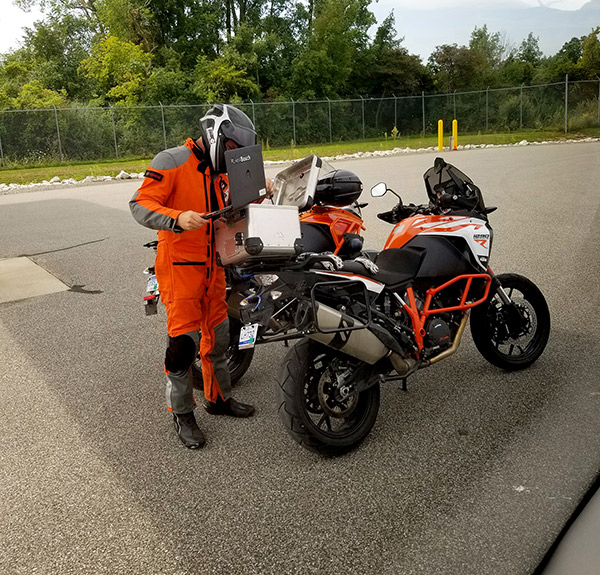AMERICAN MOTORCYCLIST MARCH 2020
Advanced driver assist on motorcycles
Bosch Developing High-Tech Solutions

By Mike Sayre
We’ve all heard about—or seen commercials for—the advanced technology now available in cars to help prevent crashes when drivers aren’t paying attention.
While the AMA has concerns that these systems—like blind spot monitoring, automatic emergency braking and adaptive cruise control—may not detect motorcycles as well as they do other vehicles, some of this same technology is making its way onto motorcycles.
Bosch, a German company that develops and supplies parts for the automotive and motorcycle industries, has been developing motorcycle-based blind spot monitoring, adaptive cruise control and even forward collision warning systems, along with the motorcycle manufacturers who hope to incorporate these technologies into future models.

G The KTM with the top case is outfitted with adaptive cruise control.
Bosch has locations and proving grounds in Michigan, which proved very convenient for me when I was back home in Ann Arbor before attending the National Association of State Motorcycle Safety Administrators conference.
My visit to Bosch’s Flat Rock Proving Grounds gave me the chance to test ride a motorcycle that had been retrofitted with radar as part of the development of Advanced Rider-Assist Systems, such as adaptive cruise control.
The bike was a KTM 1290 Super Adventure that carried front- and rear-facing radar, so the bike could detect other vehicles on all sides.
For the first run, I rode in the back of a van with Bosch engineers as another rider piloted the KTM. The van was to travel at 40 mph, while the bike would approach at about 80 mph with the adaptive cruise control set to that speed.
Sitting in the van, it was obvious the bike was roaring up to back of the van. But, as the bike approached, the Bosch engineer lifted his hands off the controls, and the bike slowed down to match the van’s speed.
After a moment, the engineer moved the bike out of the van’s lane, and the bike proceeded to accelerate to the set speed. We did this a couple more times before it was my turn.
My cruise control test
The engineer showed me how to activate the adaptive cruise control, and I was off.
It took a couple laps for me to figure out the spacing needed to get up to speed, set the cruise control and approach the van. Once I got the spacing right and approached the van at about 70 mph, the system did its job and gently slowed my speed to match that of the van.
The system brakes progressively, so there wasn’t a sudden jolt. Instead, it slowly built up to harder braking before it matched the speed of the van.
On the display of the KTM, there was the normal cruise control indicator but with the image of a car. Once a speed is set, the cruise control indicator turns green, and the image of the car stays gray.
When the system detects a vehicle ahead, the image of car turns green, letting the rider know it has detected the vehicle.
I found that the system worked through the corners, still displaying that it did, in fact, see the van as I leaned into the curve.
The Bosch engineers had explained to me earlier that while the radar components were off-the-shelf from their automotive applications, the real challenge in adapting a motorcycle came in the programming.
Unlike a car, where the radar remains in the same position relative to the horizon, the radar on the motorcycle leans with the bike and could readily detect the ground as an obstacle that suddenly came up as the motorcycle navigated a curve.
Fortunately, thanks to another Bosch system, cornering ABS, the computers on the motorcycle already “knew” that the bike was leaned. This data could be used to allow the radar to better distinguish between the ground and actual obstacles.

E This Indian motorcycle is fitted with outriggers for safety while testing the new technology.
Blind-spot monitoring
In addition to the adaptive cruise control, the same radar allowed the bike to have a functioning blind-spot-monitoring system and a forward-collision warning.
According to the engineers, the forward collision warning only pops up when the motorcycle gets very close to the vehicle ahead. So, I opted to just test the blind spot monitoring, which functioned just like it would in a passenger vehicle.
I slowed down and waved for the van to pass me. As it approached from the left rear, a light popped up on the dash and stayed on until the van was clearly in my line of sight and slightly ahead of me.
Useful features
This experience was fascinating. These were systems I wouldn’t have considered applying to a motorcycle. And, while this was a fairly controlled environment where it felt strange for the adaptive cruise control to kick in and slow the bike without any braking input from me, it wasn’t unnerving because I was paying attention and expecting it to happen.
I am very curious to see how the system functions in real-world traffic.
The Bosch engineers told me that, in Germany, they are taking adaptive cruise control-equipped motorcycles on the Autobahn and approaching semi-trucks at high speeds, which surely displays some confidence in the technology.
I must admit, I have been caught off guard by slowing or suddenly stopping traffic when I glanced down at GPS directions or some distraction on the side of the road.
Considering the proportion of motorcycle crashes that involve a motorcyclist rear-ending a vehicle in front of them, I can understand the value of a system that provides a back-up to the rider’s own sense of awareness.
Benefits evident
Bosch doesn’t see any of these systems as a replacement for rider skills. Rather, they provide a safety net to assist a rider in making the safest maneuver possible when the unexpected happens.
That day at the proving grounds in Flat Rock also included some discussion on the future.
Bosch is developing other systems that would enable motorcycles to be included in a connected-vehicle and connected-infrastructure environment.
A video demonstration showed a disabled vehicle sitting in the apex of a blind corner with a motorcycle approaching from one direction and another vehicle approaching from the opposite direction.
Both the motorcycle and the other vehicle warned their operators of the other vehicle’s presence, potentially preventing a crash while safely passing the disabled vehicle.
So far, two manufacturers have formally announced they would be incorporating this technology into their planned models. KTM and Ducati will offer radar-equipped models in the next year or two and, according to Bosch, more manufacturers will be following suit.
What does it mean?
What does this mean for the future of motorcycling?
I’m not sure. I wouldn’t say my limited experience with these systems in the controlled environment of Bosch’s test track informed me about what it would be like to use these systems in the congested environment of metro-Washington, D.C., traffic.
Just like there are still many myths about ABS on motorcycles, these systems will generate their own myths. We have seen this in the automotive world, where manufacturers compete on these features, leaving the public ill-informed on what these systems are capable of doing.
Search online for news stories about drivers abusing Tesla’s autopilot function if you have any doubts.
But there are a few implications for consideration.
Motorcycle safety benefits: Crash rates and dangerous situations could be mitigated.
Consumer confusion about capabilities: Myths may arise that exaggerate the systems’ capabilities.
First steps toward connected vehicles: Connected motorcycles have the potential to address the current shortcomings in Advanced Driver Assist Systems and automate vehicles detecting motorcycles.
Changing the perceptions of motorcycle safety culture.
Mike Sayre is the on-highway government affairs manager at the AMA.
